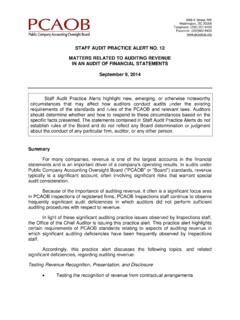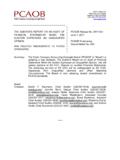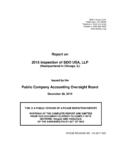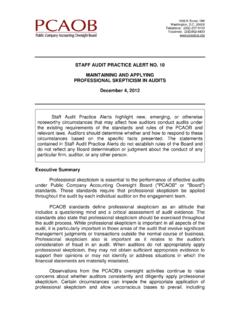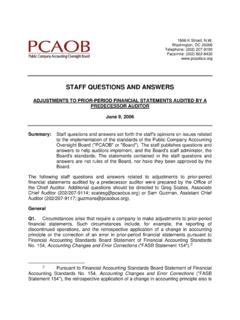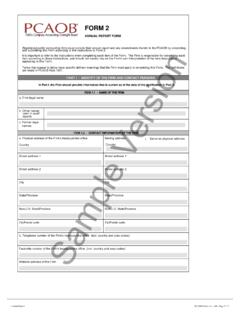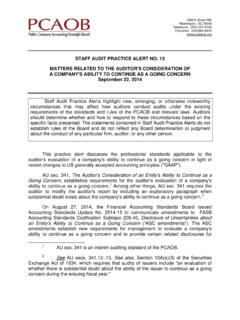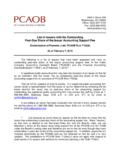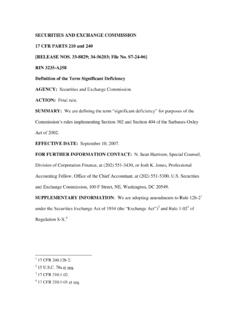Transcription of STAFF AUDIT PRACTICE ALERT NO. 11 CONSIDERATIONS ...
1 1666 K Street, NW Washington, 20006 Telephone: (202) 207-9100 Facsimile: (202)862-8430 STAFF AUDIT PRACTICE ALERT NO. 11 CONSIDERATIONS FOR AUDITS OF INTERNAL CONTROL OVER FINANCIAL REPORTING October 24, 2013 STAFF AUDIT PRACTICE Alerts highlight new, emerging, or otherwise noteworthy circumstances that may affect how auditors conduct audits under the existing requirements of the standards and rules of the pcaob and relevant laws. Auditors should determine whether and how to respond to these circumstances based on the specific facts presented.
2 The statements contained in STAFF AUDIT PRACTICE Alerts do not establish rules of the Board and do not reflect any Board determination or judgment about the conduct of any particular firm, auditor, or any other person. Summary The Office of the Chief Auditor is issuing this PRACTICE ALERT in light of significant auditing PRACTICE issues observed by the Public Company Accounting Oversight Board (" pcaob " or the "Board") STAFF in the past three years relating to audits of internal control over financial reporting ("audits of internal control").
3 The PRACTICE ALERT highlights certain requirements of the auditing standards of the pcaob in aspects of audits of internal control in which significant auditing deficiencies have been cited frequently in pcaob inspection reports. Specifically, this ALERT discusses the following topics: Risk assessment and the AUDIT of internal control Selecting controls to test Testing management review controls information technology ("IT") CONSIDERATIONS , including system-generated data and reports Roll-forward of controls tested at an interim date Using the work of others STAFF AUDIT PRACTICE ALERT No.
4 11 October 24, 2013 Page 2 Evaluating identified control deficiencies Auditors should take note of the matters discussed in this ALERT in planning and performing their audits of internal control. Because of the nature and importance of the matters covered in this ALERT , it is particularly important for the engagement partner and senior engagement team members to focus on these areas and for engagement quality reviewers to keep these matters in mind when performing their engagement quality reviews.
5 Auditing firms also should consider whether additional training of their auditing personnel is needed for the topics discussed in this ALERT . AUDIT committees of companies for which audits of internal control are conducted might wish to discuss with their auditors the level of auditing deficiencies in this area identified in their auditors' internal inspections and pcaob inspections, request information from their auditors about potential root causes of such findings, and ask how they are addressing the matters discussed in this ALERT .
6 In particular, AUDIT committees may want to inquire about the involvement and focus by senior members of the firm on these matters. STAFF AUDIT PRACTICE ALERT No. 11 October 24, 2013 Page 3 Introduction Effective internal control over financial reporting ("internal control") helps assure that companies produce reliable published financial statements that investors can use in making investment decisions. Since the 1970s, federal laws have required public companies to maintain sufficient "internal accounting controls.
7 "1/ The Sarbanes-Oxley Act of 2002, as amended, ("Act") requires company management to annually assess and report on the effectiveness of the company's internal control. For larger companies, the Act also requires independent auditors to attest to management's assessment of the effectiveness of the company's internal Auditing Standard No. 5, An AUDIT of Internal Control Over Financial Reporting That Is Integrated with An AUDIT of Financial Statements, establishes requirements for performing and reporting on audits of internal control.
8 The AUDIT of internal control should be integrated with the AUDIT of the financial statements. The objectives of the audits are not identical, and the auditor must plan and perform the work to achieve the objectives of both audits. In reporting on an integrated AUDIT of internal control and financial statements ("integrated AUDIT "), the auditor expresses an opinion on the financial statements and an opinion on the effectiveness of the company's internal control.
9 1/ See 15 78m, which was added to federal securities law by the Foreign Corrupt practices Act of 1977, which sets forth requirements for devising and maintaining a "system of internal accounting controls" sufficient to provide reasonable assurance that, among other things, transactions are recorded as necessary to permit preparation of financial statements in conformity with generally accepted accounting principles or any other applicable criteria.
10 2/ See 404 of the Act. The auditor attestation requirement applies to companies that qualify as "large accelerated filers" or "accelerated filers," other than "emerging growth companies." Pursuant to 17 , the designation of accelerated filers and large accelerated filers is based on, among other things, the aggregate worldwide market value of the voting and non-voting common equity held by non-affiliates as of the last business day of the issuer's most recently completed second fiscal quarter.
